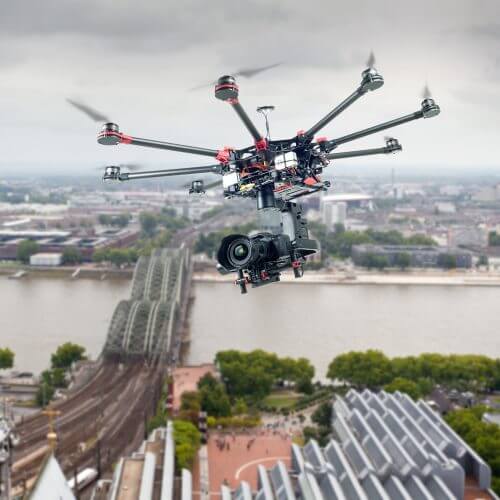Civilian multi-bladed helicopters may collide with airline jets/Jeremy Hasso
The article was published with the approval of Scientific American Israel and the Ort Israel network

A case of almost hitting a private drone forced the Shuttle America plane to crash when it was in the final stages of landing at New York's LaGuardia Airport in early 2015. This was not the first time. [A similar case happened at Ben Gurion Airport in August 2015 in which a drone approached a Brussels Airlines plane during landing and almost hit it - the editors.]
The American Aviation Administration (FAA) receives about 60 reports a month from pilots about incidents in which drones were probably involved. No one knows exactly how bad the damage would be from a small drone hitting a jet engine or body, but the FAA plans to investigate the possibility in fiscal year 2016. Meanwhile, technologies and policies that could prevent such collisions are still up in the air.
The current prevention tactic is to prevent a repeat of the offense. The FAA is cooperating with local law enforcement agencies in contacting drone operators who engage in "unauthorized operation [of an unmanned aerial system]" to enforce aviation safety regulations. The authority can also impose civil penalties for "negligent or wild operation" of a drone. But educating the citizens will not be enough to prevent accidents, says Ben Berman, a Boeing 737 pilot at a major American airline. "For the most part, near-collisions will end in nothing," he explains. "But if we roll the dice enough times a year, eventually an accident will occur."
According to the FAA classification, small drones, weighing less than 25 kilograms, cannot carry the relatively heavy anti-collision systems that larger aircraft use to detect nearby aircraft. Instead, Berman, a former chief researcher at the American National Transportation Safety Board, believes that drone manufacturers must program them in such a way that they do not raise them above a certain height and that they do not enter areas where air traffic is prohibited. The FAA has also indicated that the installation of such geo-fencing software may be a short-term solution, but it does not require it from small drone manufacturers.
The maker of one of the best-selling drones has already taken action. The DJI company from Shenzhen, China produces the most popular drones in the world. Its Phantom model costs about a thousand US dollars. Since 2014, DJI has issued software updates that clearly show the aircraft operator the closed airspaces near airports, in Washington, D.C. for example, or near international borders. An operator who ignores the software's warnings about closed airspace and tries to fly his drone into it will find that it simply refuses to move. "It's like running into an invisible wall," says DJI's Michael Perry.
A few other tactics may be on the horizon. In February 2015, the FAA proposed rules for operating drones that include speed and altitude limits and access restrictions to airspace that manned aircraft often pass through. The determination of the laws will be completed perhaps as early as 2016. In the technological aspect, NASA is collaborating with industry parties in developing an unmanned air traffic control system that can track small drones from aircraft carriers. The space agency has also tested a detection and collision avoidance system for larger unmanned vehicles, such as its Ikhana drone, a civilian version of the military's Predator. Eventually, it will be possible to miniaturize this technology and install it in smaller drones.
These solutions are becoming more and more necessary as more and more drones reach the hands of ordinary consumers. China exported 160,000 civilian drones worth $120 million from January to May 2015, according to a report by the Chinese news agency Xinhua. "We are in the process of moving from a product for a very limited hobbyist audience to a mass consumer product," says Perry. "Many consumers who are just entering this field, do not know the rules and regulations as aviation enthusiasts once did."

2 תגובות
The solution is by way of legislation. Anyone who wants to claim possession of a drone must obtain a license and must make a declaration. What does he need it for? Whoever acts against the law will be fined.
It doesn't seem to me that Ikhana is a drone, just as Predator is not a drone, but a normal UAV (and not a quadrocopter).